| Astroceramus | |
|---|---|
 | |
| Astroceramus eldredgei | |
| Scientific classification | |
| Kingdom: | |
| Phylum: | |
| Class: | |
| Order: | |
| Family: | |
| Genus: | Astroceramus Fisher, 1906 [1] |
| Species | |
See text | |
Astroceramus is a genus of abyssal sea stars in the family Goniasteridae.
| Astroceramus | |
|---|---|
 | |
| Astroceramus eldredgei | |
| Scientific classification | |
| Kingdom: | |
| Phylum: | |
| Class: | |
| Order: | |
| Family: | |
| Genus: | Astroceramus Fisher, 1906 [1] |
| Species | |
See text | |
Astroceramus is a genus of abyssal sea stars in the family Goniasteridae.
"Astrocramus" is made up of two Latin root words, "Astrum" which means star, and "ceramo" meaning tile. This clearly tells the shape of the organism; star shaped tile of all its species. [2]
According to World Register of Marine Species: [1]

The Asterinidae are a large family of sea stars in the order Valvatida.

Coscinasterias is a genus of sea stars of the family Asteriidae.
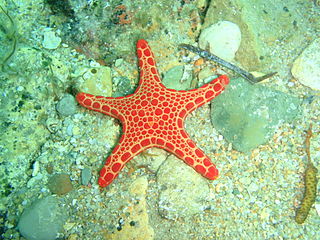
Goniasteridae constitute the largest family of sea stars, included in the order Valvatida. They are mostly deep-dwelling species, but the family also include several colorful shallow tropical species.
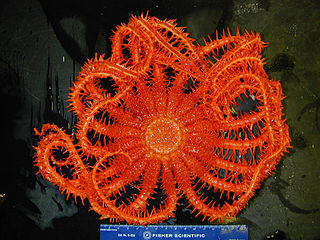
The Brisingids are deep-sea-dwelling starfish in the order Brisingida.
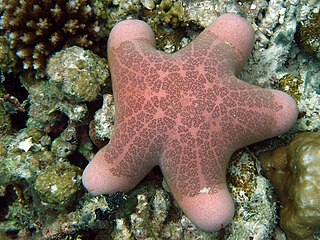
The Oreasteridae are a family of sea stars in the class Asteroidea.

Astrosarkus idipi is a species of sea stars in the family Oreasteridae. It is the sole species in the genus Astrosarkus. It is sometimes referred to as a "Pumpkin sea star".
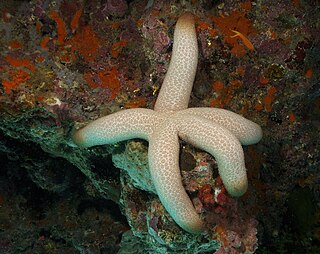
Thromidia is a genus of starfish in the family Mithrodiidae.

Luidia magnifica, the magnificent star, is a species of starfish in the family Luidiidae. It is found in the Pacific Ocean.
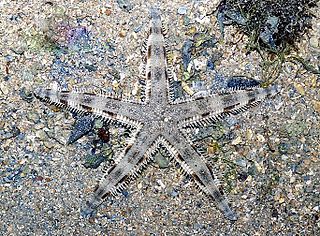
Archaster typicus is a species of starfish in the family Archasteridae. It is commonly known as the sand star or the sand sifting star but these names are also applied to starfish in the genus Astropecten. It is found in shallow waters in the Indo-Pacific region.

Hippasteria is one of 70 genera of sea star in the diverse family Goniasteridae.
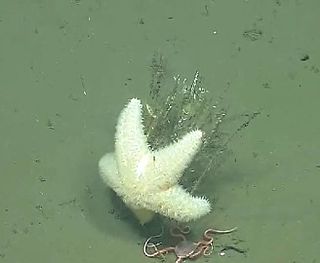
Poraniopsis inflata, the spiny sea star, is a species of starfish in the family Poraniidae. It is native to the Pacific Ocean and is found in deep water off the coast of North America.
Trophodiscus almus is a species of starfish in the family Astropectinidae. It is found in fairly deep waters in the Sea of Okhotsk, the Sea of Japan and around the Japanese island of Hokkaido. It is very unusual among starfish in that it broods its young on its upper surface. Its common name in Japanese is "Komochi-momiji".
Trophodiscus is a genus of starfish in the family Astropectinidae. There are only two species, both found in fairly deep waters in the Sea of Okhotsk. Trophodiscus almus is also found in the Sea of Japan and around the Japanese island of Hokkaido. These starfish are very unusual in that the young are brooded on the upper surface of the female.

Pterasteridae is a family of sea stars in the order Velatida, consisting of eight genera.
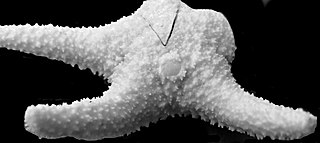
Bathyporania ascendens is a species of starfish in the family Poraniidae, and the only species of the genus Bathyporania. It is native to the Pacific Ocean and is found in deep water off the coast of North America.

Clavaporania fitchorum is a species of starfish in the family Poraniidae. It is the only known species of the genus Clavaporania. It is native to the South Pacific Ocean and is found in deep water off the coast of Australia.

Evoplosoma is a genus of deep-sea sea star in the family Goniasteridae.

Apollonaster is a genus of abyssal sea stars in the family Goniasteridae. They can be identified by their bare abactinal plate surfaces and multiple accessory granule rows on their abactinal plates. To date, Apollonaster has been found in the tropical Atlantic region and Hawaiian Islands region oceans, with no other locations or species being known as of 2015.

Hippasteria muscipula is one of twelve species of deep-sea sea star in the genus Hippasteria, which is in the family Goniasteridae.
Rathbunaster is a monospecific genus of sea stars belonging to the family Asteriidae.